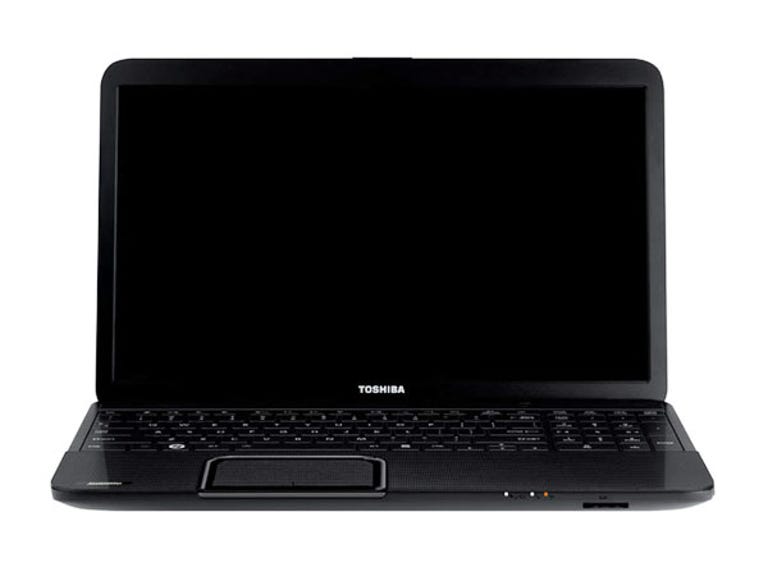 Why You Can Trust CNET
Why You Can Trust CNET Toshiba Satellite C850/02D review: Toshiba Satellite C850/02D
By itself, Toshiba's Satellite C850/02D does OK; however, AU$100 more will get you better battery life, build quality and gigabit Ethernet from its competitors.
If you're into big, black and old school, Toshiba has you covered with the Satellite C850/02D. While the external is gloss coated with a grid-like texture underneath, the inside presents a matte, textured surface, which keeps the fingerprints away, but it won't be to everyone's taste. We're not too fussed, but the textured touch pad does feel a little odd.
The Good
The Bad
The Bottom Line
Connectivity
- USB 3.0: 1
- USB 2.0: 2
- Optical: DVD±RW
- Video: VGA, HDMI
- Ethernet: 100Mbps
- Wireless: 2.4GHz 802.11n
The 15.6-inch, 1366x768 TN LG screen is passable, and, while the sound can get loud, the speakers are quite cheap and they lose plenty of the detail in the audio — try to use headphones only, if possible.
The keyboard flexes a little when typing, but this doesn't impact speed or accuracy. It doesn't offer much resistance or feedback when typing, though, with the net effect being that it feels "dead" compared to other keyboards. Like a few vendors these days, Toshiba inverts the function keys — that is, they adjust brightness, volume or perform other functions as default, with F1-F12 being accessible by holding down the Fn key first. While this isn't usually an issue, we found that Alt+F4, the shortcut for closing programs in Windows, didn't function when we had to hold down the Fn key to activate it.
The touch pad is simply standard Synaptics and, as tends to be the case with cheaper laptops, has two separate physical buttons below the pad, which is something that we prefer to the current trend of all-in-one click pads.
Toshiba carries on the annoying habit of putting port labels under the laptop, making them useless. It makes this even worse by etching them rather than colouring them, creating a black-on-black effect that's difficult to see. Still, it should be pretty easy to determine what's what, given that Toshiba colours its USB 3.0 port blue.
Yes, although the standard these days is two USB 3.0 ports, Toshiba's only given one here, supporting it with two USB 2.0 ports instead. You also get separate headphone and microphone jacks, HDMI and VGA out, 100Mbps Ethernet, a DVD&plusm;RW drive, 2.4GHz 802.11n and Bluetooth for connectivity.
Toshiba has kept the price low by making the Satellite C850/02D a last-generation part — that is, it features Intel's Core i5 2450M @ 2.5GHz. Keeping it company is 4GB of RAM, a 500GB mechanical hard drive and an AMD Radeon HD 7610M.
Application performance
Choose a benchmark: Handbrake | iTunes | Photoshop | Multimedia
No surprises for the hardware involved; the AU$899 C850/02D jostles shoulders with the similarly specced Sony Vaio E and Acer Aspire V3. Both of its direct competitors do offer better build quality and gigabit Ethernet, though.
Gaming performance
 | ||
| Batman: Arkham Asylum | ||
| Playable on: | ||
| MEDIUM | ||
| settings | ||
| FPS | ||
| Max | Avg | Min |
| 125 | 86 | 46 |
| 1366x768, 4x AA, Detail level: Medium, PhysX off. | ||
| Metro 2033 | ||
| Playable on: | ||
| VERY LOW | ||
| settings | ||
| FPS | ||
| Max | Avg | Min |
| 59 | 32 | 9 |
| 1366x768, DirectX 9, 0x AA, Quality: Low, PhysX: Off. | ||
| The Witcher 2 | ||
| FPS | ||
| Max | Avg | Min |
| 26 | 19 | 12 |
| 1366x768, low spec. | ||
| Skyrim | ||
| Playable on: | ||
| VERY LOW | ||
| settings | ||
| FPS | ||
| Max | Avg | Min |
| 60 | 40 | 31 |
| 1366x768, low detail. | ||
The low-level Radeon HD 7610M is well suited to the resolution involved, but it's not a gaming GPU by a long shot.
This is where Toshiba comes undone — for just AU$100 more, Sony and HP offer significantly better battery life, not to mention build quality.
Conclusion
By itself, Toshiba's Satellite C850/02D does OK; however, AU$100 more will get you better battery life, build quality and gigabit Ethernet from its competitors.


